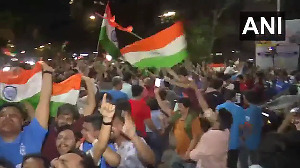Armed with the information that bomb was Improvised Explosive Device with a secondary charge of Ammonium Nitrate Fuel Oil the authorities investigating the serial bomb blasts are trying to reconstruct the events before the blasts.
Three blasts took place in span of 15 minutes and considering the locations of the three sites, investigators are not ruling out the possibility of a safe house in Mumbai where the terrorists would have rigged the three bombs and then proceeded to place them at the three sites.
The Anti-Terrorist Squad are postulating the idea of a safe house as it would be dangerous to travel with a completely rigged IED bomb over long distances as it may trigger the primary charge which is unstable and requires only a spark to go off. Moreover with police patrolling at various places in and around Mumbai, the risk of being caught with a completely rigged bomb is high.
As Zaveri Bazaar and Opera House are within a kilometer of each other and Dadar is about 10-11 km and 30 minutes drive from both the sites and, the investigators are looking for a safe house close either close to Zaveri Bazaar or Opera House.
With the safe house coming into picture the investigators are not ruling out the possibility of local support either knowingly or unknowingly to the terrorists. An expert in the bomb disposal squad said that it would have taken more than one person to rig an ANFO bomb. There would be three separate teams that would have headed to the three locations to place the bomb.
Suicide bomber ruled out
After initial speculation the possibility of a suicide bomber has been ruled out after an identified body was found with a circuit embedded in its right leg. The investigators are relying on science and circumstantial evidence to make this conclusion as the person carrying the bomb would have blown to pieces due to shock waves emanating from the bomb.
These shock waves reduce everything to bits and this is the reason why bomb blasts victims are found with their clothes in tatters. A bomb expert gave the analogy of effect of bomb shock wave on a person standing close to a mud ball hurled on a wall with force. On impact the ball burst into small fragments. That is exactly what happened with one of the victims at Zaveri Bazaar. The police and rescuers were only able to find the head of deceased identified as Kisan Shivsadan (35). There was no trace of his body.
"There is a possibility that this person was standing close to the bomb and his entire body blown into small fragments by the shock waves of the bomb. ANFO though being low intensity bomb creates tremendous shock waves in its immediate radius," said the bomb expert.
He added that if person standing close to the bomb could be blown to fragments imagine what would have happened to the body of the suicide bomber. He concluded that the body with the circuit board is probably the result of circuit from the bomb hurled as a projectile and getting embedded in the body.
Why Ammonium Nitrate/Fuel Oil?
World over ANFO is the most favoured explosive charge used by terrorists in IEDs. What makes it favourite is the fact that the basic ingredients -- ammonium nitrate is freely available as a fertilizer, whereas fuel oil which ideally has been prescribed as aviation turbine fuel (refined kerosene) or any fuel oil would do is also freely available.
Though ammonium nitrate in itself is an explosive possessing 75 percent the power of TNT, combining it with fuel enhances it destructive power several times over. ANFO is a lethal combination and though both are combustible to create a bang, it needs a dynamite detonator as the usual primary charge of blasting caps are not sufficient to trigger an ANFO to explode. Thus for the ANFO there are two stages, first the spark triggered by a timer device. This spark ignites the primary charge which is usually a blasting cap and which in turn detonates dynamite and this would then detonate the ANFO.
"Once the timer is triggered all these stages happens within a fraction of a second and people may hear only one big bang," said the bomb expert. Thus the investigators are looking at window of 15-30 minutes for the terrorists to have placed the bomb and fled the scene. To get a visual of the terrorists the investigators have also collected CC TV footage from various locations in and around the site of the blasts.









 © 2025
© 2025